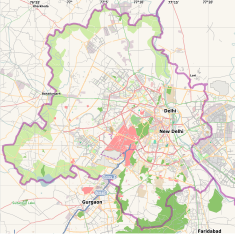| Shish Gumbad | |
|---|---|
 Shish Gumbad at Lodhi Gardens | |
| Type | Tomb |
| Location | Lodhi Gardens |
| Coordinates | 28°35′37.3884″N 77°13′12.6192″E / 28.593719000°N 77.220172000°E |
| Built | 1489-1517 CE |
| Architectural style(s) | Islamic & Hindu architecture |
| Governing body | Archaeological Survey of India & NDMC |
| Owner | Government of Delhi |
| Official name | Shish Gumbad |
| Designated | 9 Apr 1936 |
| Reference no. | N-DL-76 |
Shish Gumbad ("glazed dome"), also spelt Shisha Gumbad, is a tomb from the Lodhi Dynasty and is thought to have possibly been constructed between 1489 and 1517 CE.[1] The Shish Gumbad (glass dome) houses graves, whose occupants are not unequivocally identifiable. Historians have suggested, the structure might have been dedicated either to an unknown family, which was part of the Lodhi family and of Sikandar Lodi's court,[2][3][4][5] or to Bahlul Lodi (died 12 July 1489) himself, who was chief of the Afghan Lodi tribe, founder and Sultan of the Lodi dynasty of the Delhi Sultanate.[6]
Shish Gumbad is situated in the Lodhi Gardens in Delhi and the area where the tomb is situated was formally called village Khairpur.[7][8]
YouTube Encyclopedic
-
1/5Views:550648500140 0204 020
-
Shish Gumbad, Delhi
-
Sheesh Gumbad: Lodhi Garden Ep6
-
Inside Shish Gumbad, Delhi
-
Enjoying Delhi's Green Paradise 🇮🇳
-
EP : Lodhi Gardens | BADA GUMBAD MASJID | Archaeological Survey of India | ASI | MINORITIES NEWS
Transcription
History
Exact date of construction of Shish Gumbad is not known. There are four monuments (tombs) in the Lodhi Gardens including the Shish Gumbad. The oldest of the four tombs is the tomb of Muhammad Shah (who belonged to the Sayyid dynasty). Shah's tomb was constructed in 1444 CE by Ala-ud-din Alam Shah. During the rule of Sikander Lodhi, the Bara Gumbad and adjacent mosque were constructed. Sikander Lodhi's tomb was built by Ibrahim Lodhi in 1517. The Shish Gumbad is said to have been constructed between 1489-1517 CE by Ibrahim Lodhi.[8][9][unreliable source?]
Among historians there is no agreement, who are the occupants of the graves inside the structure. The Shish Gumbad might have been dedicated either to an unknown family, which was part of the Lodhi family and of Sikandar Lodi's court,[2][3][4][5] or to Bahlul Lodi (died 12 July 1489) himself, who was chief of the Afghan Lodi tribe, and founder and Sultan of the Lodi dynasty of the Delhi Sultanate.[6][10][11]
Initially, all the monuments were built independently and were not in one confine. In early 20th century, a park was developed which was inaugurated by Lady Willingdon on 9 Apr 1936 bringing the four monuments in one confine.[8]
Construction
Constructed between 1489-1517 CE, the Shish Gumbad is constructed in square shape. Combination of bracket and lintel beams, the architecture is a blend of Islamic and Indian architectures. Although the Gumbad has an external semblance of spanning in two floors, the structure made only in one floor. The western wall of the Gumbad consists of mihrab which also served as a mosque. The main chamber of the monument measures 10 square metres (108 sq ft).[12][13]
The ceiling is decorated with plaster work that contains Quranic inscriptions and floral designs. The monument was originally decorated with blue enamelled tiles that shined like glass. The Gumbad hence got its name "Shish Gumbad". The blue tile embellishment presently only remains on top of the main frontage in traces.
Location
The Shish Gumbad is located in and is a part of the Lodhi Gardens in Delhi, India. The village, where the monument stands was earlier called Khairpur. The garden is bounded by Amrita Shergill Marg in the West, North-West and North, Max MuellerMarg on the East and Lodhi Road on the South Side. Safdarjang Tomb is situated on South-West corner of the Lodhi Garden.
Picture gallery
-
Monument information board displayed in Lodhi gardens.
-
Rear view of Shish Gumbad
-
Tiles on top of main entrance
-
Dome interior ceiling
-
Graves in main chamber
-
Carvings on South entrance
-
Shish Gumbad view from south (main entrance) side
-
Bara Gumbad Shish Gumbad
See also
- Bara Gumbad
- Lodhi Gardens
- Tomb of Bahlul Lodi
- Tomb of Sikandar Lodi
- Ibrahim Lodhi's Tomb
- List of Monuments of National Importance in Delhi
References
- ^ "Unknown Tomb". competentauthoritydelhi.co.in. Retrieved 15 October 2015.
- ^ a b "Who rests under that dome". The Hindu. Retrieved 15 October 2015.
- ^ a b "Tombs within Lodhi Gardens". Delhi information website. Retrieved 15 October 2015.
- ^ a b "Lodhi Garden attraction". Expedia. Retrieved 15 October 2015.
- ^ a b "Heritage of the Gumbads". Delhi: Unknown Tales of a City (Chapter 32). 30 May 2015. ISBN 9789351941255. Retrieved 15 October 2015.
- ^ a b Simon Digby, The Tomb of Buhlul Lodi, The Bulletin of SOAS, Vol. 38, No. 3, 1975, pp. 550–61.
- ^ "Alphabetical List of Monuments in Delhi". Archaeological Survey of India. Retrieved 15 October 2015.
- ^ a b c "Important gardens" (PDF). New Delhi Municipal Council. Archived from the original (PDF) on 10 December 2015. Retrieved 15 October 2015.
- ^ "Bara Gumbad". orientalarchitecture.com. Retrieved 15 October 2015.
- ^ C.E. Bosworth, The New Islamic Dynasties, (Columbia University Press, 1996), 304.
- ^ "Ten sites in Delhi you must visit". Zee News. Retrieved 15 October 2015.
- ^ "Bystanders of the past". The Hindu. Retrieved 15 October 2015.
- ^ "Lodhi Gardens, New Delhi". fiftyplustravels.com. Retrieved 15 October 2015.









